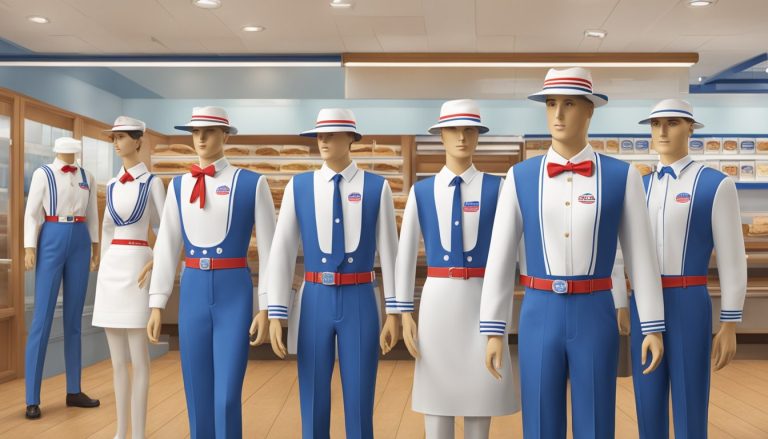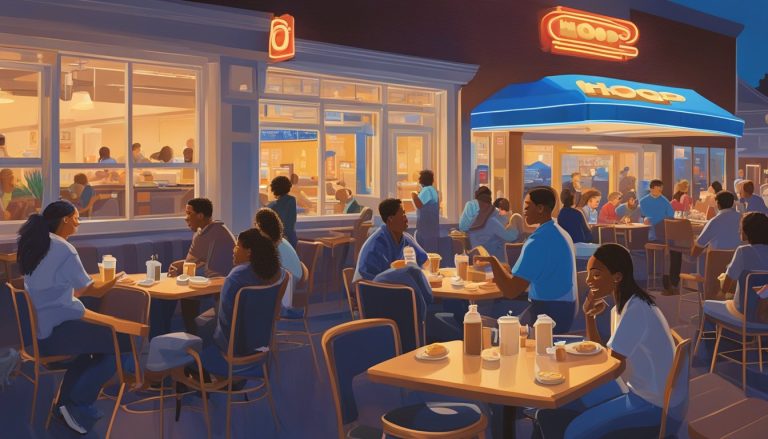The International House of Pancakes, better known as IHOP, has become an integral part of American road trip culture since its founding in 1958. As millions of Americans hit the open road each year, IHOP restaurants serve as familiar beacons along highways and interstates, offering comfort food and a place to rest.
IHOP’s ubiquitous presence along major travel routes has made it a go-to pit stop for road trippers seeking a hearty meal and a break from driving. The restaurant’s 24/7 operating hours in many locations cater perfectly to the unpredictable schedules of travelers, allowing them to satisfy their cravings for pancakes and other diner fare at any time of day or night.
IHOP’s role in road trip culture extends beyond mere convenience. For many travelers, stopping at an IHOP has become a tradition, a way to mark the beginning or end of a journey. The restaurant’s consistent menu and familiar atmosphere provide a sense of comfort and continuity amid the ever-changing landscapes of the American road trip experience.
The Evolution of American Road Trips

Road trips transformed from a novelty to a beloved American tradition over the course of the 20th century. This evolution was shaped by technological advancements, infrastructure developments, and cultural shifts that redefined how Americans explored their country.
The Advent of the Automobile
The introduction of affordable automobiles, particularly the Ford Model T in 1908, marked the beginning of road trip culture. These vehicles gave Americans unprecedented mobility and freedom to travel. Early road trippers faced challenges like unreliable cars, poor road conditions, and limited amenities.
As automobile technology improved, more families could afford cars. This led to increased leisure travel in the 1920s and 1930s. Road trips became a way for Americans to escape city life and explore rural areas. The Great Migration also saw many African Americans using road trips to relocate to northern cities.
Rise of the Interstate Highway System
The Interstate Highway System, launched in 1956, revolutionized road travel in America. This network of high-speed roads connected major cities and made long-distance driving faster and safer. It also led to the growth of roadside attractions, motels, and restaurants catering to travelers.
The new highways allowed Americans to cover greater distances in less time. This expanded the possibilities for road trip destinations and routes. Families could now easily plan cross-country vacations, visiting national parks and landmarks along the way.
Cultural Milestones in Road Tripping
Jack Kerouac’s 1957 novel “On the Road” captured the spirit of freedom and adventure associated with road trips. It influenced the Beat Generation and later counterculture movements, cementing the road trip as a symbol of personal discovery and rebellion.
The 1960s and 1970s saw road trips become closely tied to music and youth culture. Rock bands toured the country, and young people hit the road to attend festivals like Woodstock. Road trips represented independence and a break from societal norms.
By the late 20th century, road trips had become deeply ingrained in American culture. They featured prominently in films, books, and music, often portrayed as journeys of self-discovery or family bonding. The open road continued to symbolize freedom and the pursuit of the American Dream.
IHOP’s Place in Road Trip Tradition
IHOP has become a beloved fixture for travelers seeking familiar comfort food on long journeys. The restaurant chain’s 24/7 availability and consistent menu have made it a go-to stop for road-trippers across America.
The Establishment of IHOP
IHOP, short for International House of Pancakes, opened its first location in 1958 in Toluca Lake, California. The founders, Al and Jerry Lapin, envisioned a restaurant that would specialize in pancakes and breakfast foods. IHOP quickly expanded, with locations popping up along major highways and in suburban areas.
By the 1970s, IHOP had become a recognizable brand across the United States. Its blue roof and distinctive signage made it easy for travelers to spot from the road. The chain’s growth coincided with the increasing popularity of road trips, positioning IHOP as a convenient dining option for motorists.
Connecting Diners and Drivers
IHOP’s strategic placement near highways and interstates has solidified its role in road trip culture. Many locations offer ample parking for cars, RVs, and even trucks, catering to various types of travelers. The restaurant’s 24-hour service is particularly appealing to long-distance drivers who may be on the road at odd hours.
The menu’s focus on hearty breakfast foods provides road-trippers with fuel for their journeys. Pancakes, eggs, and coffee have become staples for drivers looking to start their day or recharge during a late-night drive. IHOP’s consistency across locations offers a sense of familiarity and reliability for travelers far from home.
IHOP has also embraced its connection to American road trip culture through marketing campaigns. Promotions often highlight the restaurant as a road trip destination, encouraging travelers to include IHOP in their itineraries.
Diner’s Role as a Social and Cultural Hub

Diners like IHOP have played a significant part in American culture as social gathering places. They offer a welcoming environment where people from all walks of life can come together over a meal.
Along iconic routes like Route 66, diners became essential stops for travelers. They provided familiar comfort food and a place to rest, becoming integral to the road trip experience.
These establishments have witnessed important moments in American history. During the Civil Rights era, some diners served as meeting points for activists. The Negro Motorist Green Book listed safe dining spots for African American travelers.
Diners often reflect the values of their communities. In some areas, they may attract a more conservative clientele, while in others, they draw a liberal crowd. This diversity showcases America’s cultural tapestry.
The nostalgic appeal of diners resonates with many Americans. Their classic decor, jukebox music, and all-day breakfast menus evoke memories of simpler times.
IHOP, with its recognizable blue roof, has become a modern incarnation of the traditional diner. It maintains the welcoming atmosphere while adapting to changing tastes and dietary needs.
Culinary Contributions to Road Tripping

Road trip food has evolved from basic provisions to diverse culinary experiences that cater to travelers’ tastes and convenience. The landscape of roadside dining offers options ranging from hearty breakfasts to quick fast food meals.
The Significance of Breakfast Foods
Breakfast holds a special place in road trip culture. IHOP, with its extensive menu of pancakes, waffles, and egg dishes, has become a popular stop for early morning travelers. The restaurant’s 24-hour service accommodates varied road trip schedules.
Many drivers opt for IHOP’s hearty breakfast platters to fuel long drives. The chain’s familiar blue roof serves as a beacon for hungry travelers seeking a reliable meal before hitting the road.
Portable breakfast items like breakfast sandwiches and burritos have gained popularity for their ease of consumption while driving. These on-the-go options allow travelers to maximize driving time without sacrificing a morning meal.
Fast Food and Road Trip Convenience
Fast food chains play a crucial role in road trip dining. Their ubiquity along highways and interstates ensures travelers can find familiar meals quickly. Drive-thru services cater to those eager to minimize stops and continue their journey.
Burgers remain a road trip staple, offering a satisfying and easily eaten meal. Many fast food restaurants have expanded their menus to include healthier options, catering to health-conscious travelers.
Value menus and combo meals provide cost-effective dining solutions for budget-conscious road trippers. The standardization of fast food ensures consistent quality and taste across different locations, giving travelers a sense of comfort and reliability during their journeys.
Roadside Attractions and Entertainment

Road trips often include stops at unique roadside attractions and eateries that have become integral to American travel culture. These destinations offer memorable experiences and a break from long hours of driving.
Creating Memories at IHOP
IHOP, with its iconic blue roof and A-frame design, has been a familiar sight for road trippers since 1958. The restaurant chain’s 24/7 service makes it a convenient stop for travelers at any time of day or night. IHOP’s extensive menu, featuring its famous pancakes and hearty breakfast options, caters to diverse tastes and dietary needs.
Many families have created lasting memories over stacks of pancakes and cups of coffee at IHOP during their road trips. The restaurant’s consistent quality and familiar atmosphere provide a sense of comfort to weary travelers far from home.
The Appeal of Roadside Oddities
Quirky roadside attractions have been drawing curious travelers since the early 1900s. These unique stops range from giant statues and unusual museums to themed parks and natural wonders. They offer a glimpse into local culture and history, often becoming destinations in their own right.
Popular roadside attractions include:
- The World’s Largest Ball of Twine (Cawker City, Kansas)
- Cadillac Ranch (Amarillo, Texas)
- Dinosaur sculptures (various locations)
These attractions provide entertainment, photo opportunities, and a chance to stretch legs during long drives. They contribute to the charm and adventure of the all-American road trip experience.
Practical Considerations for Road Trippers

Road trips require careful planning and preparation to ensure a smooth journey. Knowing how to handle pit stops and unexpected mechanical issues can make or break the adventure.
Navigating Gas Stations and Meal Breaks
Gas stations serve as crucial waypoints for road trippers. It’s wise to refuel when the tank reaches half-empty, especially in remote areas. Many stations offer loyalty programs, providing discounts on fuel and snacks.
For meal breaks, seek out local diners or cafes to experience regional cuisine. These establishments often provide a more authentic taste of the area compared to fast-food chains.
Some gas stations feature convenience stores with a variety of snacks and drinks. Stock up on water and non-perishable items for the journey. Many modern stations also offer electric vehicle charging points, catering to the growing number of eco-conscious travelers.
Addressing Mechanical Breakdowns
Vehicle maintenance is crucial before embarking on a road trip. Check tire pressure, oil levels, and coolant before departure. Pack an emergency kit including jumper cables, a flashlight, and basic tools.
If a breakdown occurs, safely pull over to the shoulder. Turn on hazard lights and place reflective triangles behind the vehicle. For minor issues like flat tires, many drivers can handle the repair themselves.
For more serious problems, contact roadside assistance or a local mechanic. Many insurance policies and auto clubs offer towing services. It’s advisable to have these contact numbers readily available.
In remote areas, limited cell service may pose challenges. Consider carrying a satellite phone or emergency beacon for such situations. Some navigation apps offer offline maps, which can be invaluable when signal is scarce.
Modern-Day Road Tripping

Road trips have evolved with technology and changing travel preferences. Today’s journeys blend convenience with adventure, attracting a diverse range of travelers seeking unique experiences.
Embracing Flexibility and Spontaneity
Modern road trips prioritize flexibility. GPS and navigation apps allow drivers to easily adjust routes on the fly. Travelers can discover hidden gems and local attractions with just a few taps on their smartphones.
Spontaneous detours have become a hallmark of contemporary road tripping. Weekend getaways and impromptu adventures are more accessible than ever. Booking apps make it simple to find last-minute accommodations, from hotels to campgrounds.
Roadtrippers now have the freedom to craft personalized itineraries. They can mix urban exploration with nature escapes, catering to varied interests within a single trip.
The New Wave of Roadtrippers
Today’s road trip culture attracts a diverse crowd. Young professionals seek brief escapes from city life. Families bond over shared experiences on the open road. Digital nomads combine work and travel, utilizing Wi-Fi hotspots at rest stops.
Social media plays a significant role in modern road trips. Travelers share real-time updates and photos, inspiring others to embark on their own journeys. Online communities offer tips and recommendations for fellow roadtrippers.
Eco-conscious travelers are increasingly common. They opt for fuel-efficient or electric vehicles, plan routes with charging stations, and choose sustainable accommodations like eco-lodges or camping sites.
Exploring the Wider Impact of Road Trip Culture

Road trip culture has profoundly shaped American society, influencing everything from literature and media to urban development and personal independence. Its effects extend far beyond the highways themselves.
IHOP’s Contribution to an Enduring Legacy
IHOP has become an integral part of American road trip culture. With its 24/7 availability and widespread presence along major highways, IHOP offers travelers a reliable pit stop for meals and rest. The restaurant chain’s blue roof has become a beacon for weary drivers seeking comfort food and a break from the road.
IHOP’s menu, featuring classic American breakfast items, appeals to road trippers looking for familiar tastes. The chain’s marketing often emphasizes its role in road trip adventures, reinforcing its place in the cultural imagination.
For many modern gypsies and long-haul truckers, IHOP serves as a home away from home. Its consistent atmosphere and menu provide a sense of stability amid the constant motion of life on the road.
Road Trip Culture in Media and Literature
Road trip narratives have become a staple in American literature and film. Works like Jack Kerouac’s “On the Road” and films such as “Easy Rider” have romanticized the idea of the open road as a path to self-discovery and freedom.
These stories often highlight the contrast between urban environments and the vast, open spaces of America’s highway system. They explore themes of independence and personal growth through travel.
The road trip genre has evolved to reflect changing societal values. Modern works like David Lynch’s “The Straight Story” offer a more nuanced view of road trip culture, examining its impact on small-town America and individual lives.
Television shows and documentaries frequently feature road trips, further cementing their place in popular culture. These media depictions continue to inspire new generations to embark on their own journeys of exploration.




